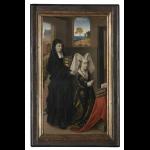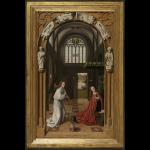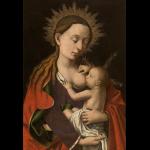This archived website 'Flemish primitives' is temporarily not being updated. Certain functionality (e.g. specific searches in the collection) may no longer be available. News updates about the Flemish primitives will appear on vlaamsekunstcollectie.be. Questions about this website? Please contact us at info@vlaamsekunstcollectie.be.
Petrus Christus
Petrus Christus is the only Bruges painter from the period between Van Eyck and Memling of whose oeuvre anything is known. The painter arrived in Bruges three years after Van Eyck's death and filled the artistic void that was left by his death. His artistic career lasted three decades in Bruges, and from this period there were thirty paintings, five drawings and one page from a manuscript attributed to Petrus Christus. Nine of these paintings are signed and dated (all between 1446 and 1457) in a style that refers to Jan van Eyck. Just as Jan van Eyck, he signed his works on the register. Seven of these signed works can be connected with other trustworthy documents. In this way they serve as the basis for the attributions of the non-signed works. Petrus Christus's painting style is eclectic. He blends influences--as well as motifs and work procedures--of Jan van Eyck, Rogier van der Weyden, and the art of miniatures into a distinct style. His works hold a crucial place in the complex development of the 15th-century Flemish painting. Christus introduced the interior protrait in which he exchanged the neutral background with the interior of a room. In addtion to commissions from Bruges families such as de Adornes, he received many assignments from businessmen from Spain and Italy.
1415 to 1420
Petrus Christus is presumably born in Baerle (Baerle-le-Duc) in the dukedom of Brabant.
1444
Mention in the Poorterboek of Bruges that Petrus Christus acquires burghership so that he can become a painter. Petrus Christus is supported by Joos van der Donc for this. Christus thus comes to Bruges just three years after the death of Jan van Eyck.
Circa 1444 - 1463
Petrus Christus marries a certain Gaudicine.
1446
Petrus Christus signs and dates a portrait with "PETRUS XRI ME FECIT A 1446" of a lay brother that is probably from the Carthusian cloister of Genadedal near Bruges (The Metropolitan Museum of Art, New York). Christus does the same for a portrait of Edward Grymeston, ambassador of the English king Henry IV to the court of Philip the Good (National Gallery, London).
1446 - 1457
The nine signed and dated paintings of Petrus Christus that are preserved are dated from this period.
1449
Petrus Christus signs a painting of Goldsmith in his Shop (Saint Eligius?) (The Metropolitan Museum of Art, New York) and puts his name and the year on the register of Virgin and Child (Virgo Lactans) (Royal Museum of Fine Arts, Antwerp/ the condition is problematic).
1452
He paints two panels with the Annunciation and Nativity and the Last Judgement (Gemäldegalerie, Berlin) and also a Nativity and Annunciation (Groeninge Museum, Bruges). The last two works were the subject of a hyper-restoration in the 20th Century. Less than 30 percent of the picture surface is authentic.
1454
On 24 April, the count of Etampes orders three copies of the Miraculous Our Lady of Grace, of which it is thought that it was painted by Saint Luke himself. None of these three have been preserved. The capital of Cambrai paid Christus for costs from the church fabric.
1455
Christus signs the Lamentation (Royal Museums of Fine Arts, Brussels).
1457
Petrus Christus signs Virgin and Child Enthroned with Saint Jerome and Saint Francis (Städelsches Kunsinstitut und Städtische Galerie, Frankfurt am Main) This is the last known painting that Petrus Christus signed.
1457 - 1463
The absence of documents provides that there is very little known about the painter in this period. It was suggested that he may have stayed in Italy during, or for a part of this period, but again here all attempts to connect him with the Italian archival documents have remained fruitless as of yet.
1462 - 1463
Petrus Christus receives an assignment by the Bruges city administration.
Christus and his wife become members of the prestigious Confraternity of Our Blessed Lady of the Dry Tree, of which the Burgundian dukes were also members. Many Dutch aristocrats and foreign top merchans were also members. In 1465, for the brotherhood, Christus painted the small, and very unique panel, Madonna of the Dry Tree, which is found today in the Collección Thyssen-Bornemisza in Madrid.
1463
On 22 February, the Joyful Entrance of Philip the Good and his sister Agnes, wife of Duke Charles of Bourbon, took place in a festively decorated Bruges. Petrus Christus, together with Master painter Pieter Nachtegale, was responsible for the supervision of the construction of two enormous stage decorations in the streets of Bruges on the occasion of the festivities carried out for the Bruges Holy-Blood Procession and the visit of Philip the Good.
1465
Hans Memling establishes himself in Bruges.
1467 - 1468
Documents mention Petrus Christus's annual contributions to the important devotional community of the Confraternity of the Our Blessed Lady of the Snow, to which many other guilds and crafstmen belong, but also members of the court. It is presumable that Christus was also a member.
1467 - 1472
Christus's name repeatedly shows up in documents as spokesman for the guild of the visual artists and in his capacity as leader in the painters' corporation and other commercial organisations.
1468
On 19 April the Joyful Entrance of Charles the Bold took place in Bruges on the occasion of his marriage to Margaret of York, sister of Edward IV of England. From 3 to 12 July, the festivities took place. Among the 150 artists, invited to work on the decorations, are Jacques Daret, Hugo van der Goes, Daneel de Rijcke and Lieven van Lathem, inter alia. It is not, however, known with certainty if Petrus Christus or Hans Memlng were involved with the works.
1475 - 1476
Christus's spouse pais the last contribution for the Confraternity of Our Blessed Lady of the Snow. Petrus Christus dies between 2 September 1475 and 13 March 1476. He is buried in the Church of Our Lady. The brotherhood pais the funeral costs.
1476
On 13 March, Bastiaen Christus, a bastard son of Christus, becomes freemaster in the guild of the image-makers. Presumably he took over his father's studio with this.
1492
In the inventory of the collection of Lorenzo de' Medici, a portrait of a French noblewoman was taken as a work of "Pietro Cresti de Bruggia" (Gemäldegalerie, Berlin).
1500
On 5 May, Petrus II Christus, the grandson of Christus by Bastiaen, takes over his father's studio.
1524
Pietro Summonte mentions a painting by Petrus Christus with an enthroned Christ figure from the Sannazaro collection in Naples in a letter to Marcantonio Michiel. He calls Christus a "pictor famoso in Flandria", but he mistakenly places him in the generation of Van Eyck and Van der Weyden.
1567
Lodovico Guicciardini discusses Petrus Christus in his Descrittione di tutti i Paesi Bassi. He erroneously calls Petrus Christus a follower of Memling. Vasari takes this over in 1568 in his edition of The Lives.
Vanessa Paumen












